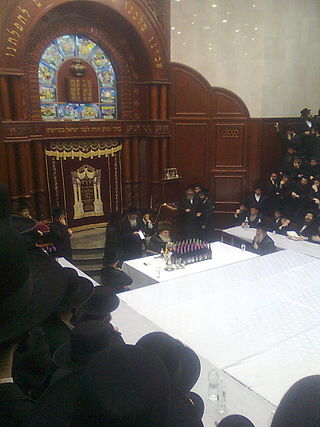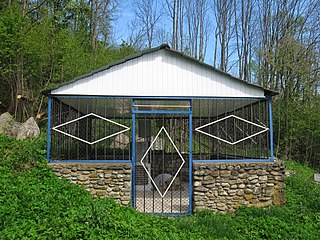
Vizhnitz is the name of a Hasidic dynasty founded by Rabbi Menachem Mendel Hager. Vizhnitz is the Yiddish name of Vyzhnytsia, a town in present-day Ukraine.

Belz is a Hasidic dynasty founded in the town of Belz in Western Ukraine, near the Polish border, historically the Crown of the Kingdom of Poland. The group was founded in the early 19th century by Rabbi Shalom Rokeach, also known as the Sar Shalom, and led by his son, Rabbi Yehoshua Rokeach, and grandson, Rabbi Yissachar Dov, and great-grandson, Rabbi Aharon, before the Nazi invasion of Poland in 1939. While Aharon managed to escape Europe, together with his brother Rabbi Mordechai Rokeach, most of the Belz Hasidim were murdered in the Holocaust. Aharon re-established the Hasidic community in Israel following World War II. As of the 2020s, Belz has sizable communities in Israel, Western Europe, and the Anglosphere.
Shotz is a Hasidic dynasty originating in the city of Suceava, Romania.

Skver is a Chasidic dynasty founded by Rebbe Yitzchok Twersky in the city of Skver, or Skvyra, in present-day Ukraine during the mid-19th century. Adherents of the rebbes of Skver are known as Skverer Hasidim.
Sulitza is a Hasidic dynasty originating in Sulitza (Sulița), Romania. The present Rebbe of Sulitza is Rabbi Yaakov Yisroel VeYeshurin Rubin. His synagogue is in Far Rockaway, Queens, NY.

Boston is a Hasidic dynasty, originally established in 1915 by Rabbi Pinchas David Horowitz, a scion of the Nikolsburg Hasidic dynasty. Following the custom of European Chassidic Courts, where the Rebbe was called after the name of his city, the Bostoner branch of Hasidic Judaism was named after Boston, Massachusetts. The most senior and well-known of the Bostoner Rebbes in contemporary times was Grand Rabbi Levi Yitzchak Horowitz, who died in December 2009.

Rabbi Moses Josef Rubin (1892–1980) was leading rabbinic figure in Romania and later in the United States, a scion of the Kosov-Seret dynasty.

Pshevorsk is a small Hasidic movement based in Antwerp, Belgium, led by the Leiser rabbinical dynasty, originating in the Polish town of Przeworsk.

Sadigura is a Hasidic dynasty named for the city of Sadhora, Bukovina, which was part of the Austrian Empire. The dynasty began in 1850 with Rabbi Avrohom Yaakov Friedman, a son of Rabbi Yisrael Friedman of Ruzhyn, and was based in Sadigura until 1914. During the interwar period the dynasty was led by rebbes in Vienna and Przemyśl, Poland, and just before World War II moved to Israel.
Ropshitz is the name of a Hasidic dynasty, or rabbinical family and group, who are descendants of Rabbi Naftali Zvi of Ropshitz (1760–1827). Ropshitz is the name of a town in southern Poland, known in Polish as Ropczyce.

Grand Rabbi Shraga Feivish Hager, also known as the Kosover Rebbe, was the rebbe of the Kosov Hasidic dynasty, a dayan, and noted orator. He was known as a creative and insightful thinker, whose original teachings were nevertheless rooted in Hasidic mystical tradition. He was also a powerful prayer-leader and attracted a large following among younger Hasidim.

Moetzes Gedolei HaTorah is the supreme rabbinical policy-making council of the Agudat Yisrael and Degel HaTorah movements in Israel; and of Agudath Israel of America in the United States. Members are usually prestigious Roshei Yeshiva or Hasidic rebbes, who are also usually regarded by many Haredi Jews to be the Gedolim ("great/est") sages of Torah Judaism. Before the Holocaust, it was the supreme authority for the World Agudath Israel in Europe.

Kosov is the name of a Hasidic dynasty founded by Rabbi Menachem Mendel Hager of Kosiv, a town in Galicia, presently in Ukraine.

Shtefanesht was a Hasidic dynasty named for the town of Ștefănești, Romania. It was one of the branches of the Ruzhiner dynasty, together with Bohush, Boyan, Chortkov, Husiatyn, and Sadigura. The dynasty lasted from 1851 to 1933 and had only two Rebbes: Rabbi Menachem Nochum Friedman, a son of the Ruzhiner Rebbe, and Rabbi Avrohom Mattisyohu Friedman, the only son of Rabbi Menachem Nochum. During the latter's reign, Ștefănești became one of the most important Hasidic centers in Eastern Europe.
Koidanov is a Hasidic dynasty originating from the city of Dzyarzhynsk (Koidanov), Belarus, where it was founded by Rabbi Shlomo Chaim Perlow (1797–1862) in 1833. Koidanov is a branch of both Lechovitch Hasidism and Karlin-Stolin Hasidism as Rabbi Shlomo Chaim Perlow was the paternal grandson of Rabbi Mordechai of Lechovitch and the maternal grandson of Rabbi Asher of Stolin. Koidanov was the smallest of the three Lithuanian Hasidic dynasties, with most of its Hasidim being murdered in the Holocaust. The dynasty was re-established after the war in Tel Aviv, then moved to Bnei Brak, where the majority of the dynasty is located, but there are Chassidim located around the world.
Dinov is the name of a Hasidic dynasty, descended from Rabbi Tzvi Elimelech Spira of Dinov, also called "the Bnei Yisaschar" after his popular work: בני יששכר [Bene Yiśaśkhar]. Dinov is the Yiddish name of Dynów, a town in southern Poland, in the historic region of Galicia.

Avrohom Yaakov Friedman, in English also spelled Abraham Jacob Friedman was the third Rebbe of the Sadigura Hasidic dynasty. He was a prominent Jewish leader in Vienna in the interwar period and in the nascent State of Israel, where he established his court in Tel Aviv. He was one of the first members of Agudat Israel and occupied a seat on the Moetzes Gedolei HaTorah.

Avrohom Yaakov Friedman was the fifth Rebbe of the Sadigura Hasidic dynasty. In 1979 he succeeded his father, the fourth Sadigura Rebbe, and took his seat on the Moetzes Gedolei HaTorah. He oversaw the growth of Sadigura communities in Israel and in London, Antwerp, and New York City.

Mordechai Hager was the rebbe of the Hasidic sect of Vizhnitz for 46 years.

Rabbi Menachem Mendel Hager of Kosov, nicknamed the "Ahavat Shalom", was a Hasidic rebbe and founder of the Kosov dynasty, which he led from 1802 until his death in 1825. He is well-known for his book, The Love of Peace.













